Home » Upper atmosphere physics (Page 2)
Category Archives: Upper atmosphere physics
Multiscale Analysis of the Turbulent Ionospheric Medium
Papers from SWICo members
P. De Michelis and R. Tozzi
The physical parameters which describe many fluid and plasma systems, such as density, velocity, temperature, and electric and magnetic fields, are often characterized by fluctuating values. When the fluctuations are observed over many spatial and temporal scales and a nonlinear transfer of energy occurs between the different scales, the system is generally said to be in a turbulent state. Several interplanetary space environments, such as solar wind, ion foreshock, the magnetosheath, and the magnetotail and, last but not least, the ionosphere, have been found to be in a turbulent state.
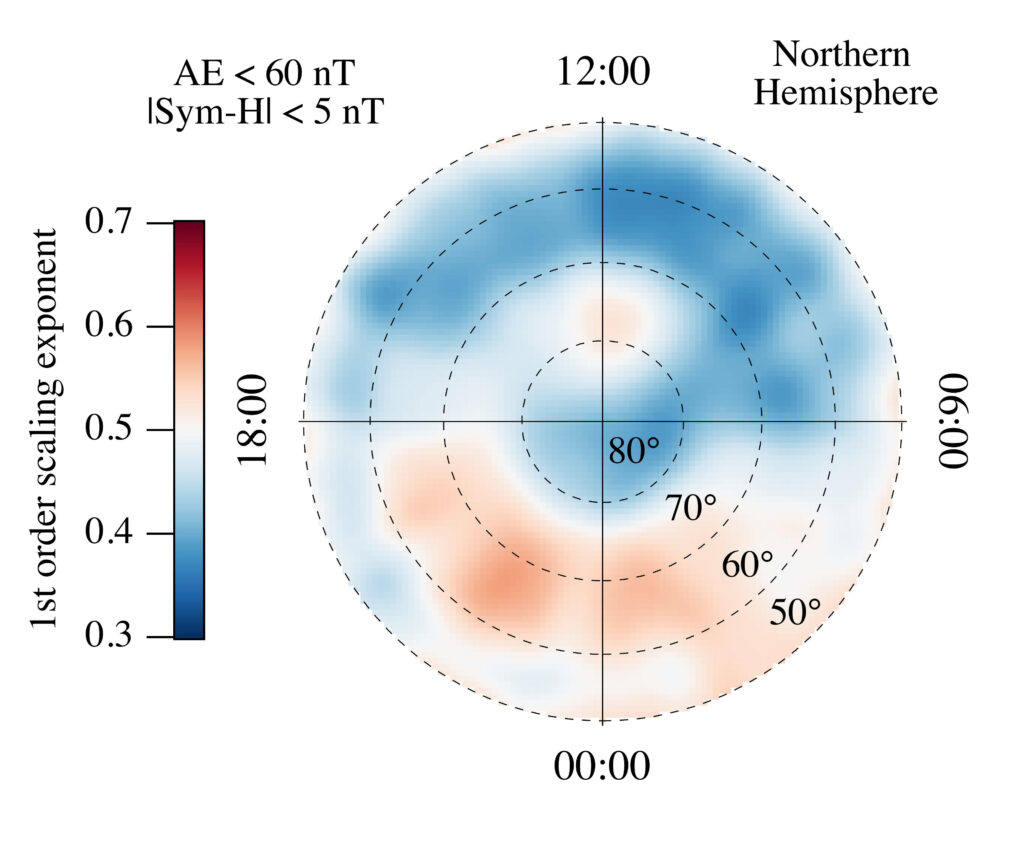
Turbulence crucially influences the cross-scale coupling of the dynamical processes: it can influence the transport of mass, momentum, and energy from solar wind and the magnetosphere to the ionosphere and can also perturb the equilibrium structure of the ionosphere, as well as the plasma dynamics and particle energization at many locations in the ionosphere. Here, we review some recent findings on the multiscale and turbulent character of the ionosphere, with a special emphasis on high-latitudes. In particular, we analyse some scaling features of magnetic field fluctuations, relating them to their spectral properties and the occurrence of intermittency phenomena.
Publication: P. De Michelis and R. Tozzi, “Multiscale Analysis of the Turbulent Ionospheric Medium”, Chapter 19 in “The Dynamical Ionosphere”, Editors: M. Materassi, B. Forte, A. Coster and S. Skone, Elsevier 2020.
https://doi.org/10.1016/B978-0-12-814782-5.00019-4
Lower-thermosphere response to solar activity: an empirical-mode-decomposition analysis of GOCE 2009-2012 data
Papers from SWICo members
Alberto Bigazzi, Carlo Cauli, and Francesco Berrilli
The thermosphere is a layer of the high Earth atmosphere which extends into the Low Earth orbit (LEO) region. It is extremely sensitive to the activity of our star, especially to solar radiation in X-rays and ultraviolet. When the sun is at a minimum of activity, as in these years, its X-rays and UV emission is reduced and the thermosphere cools and collapses. On the contrary, when solar activity increases the thermosphere expands and penetrates into circumterrestrial space.
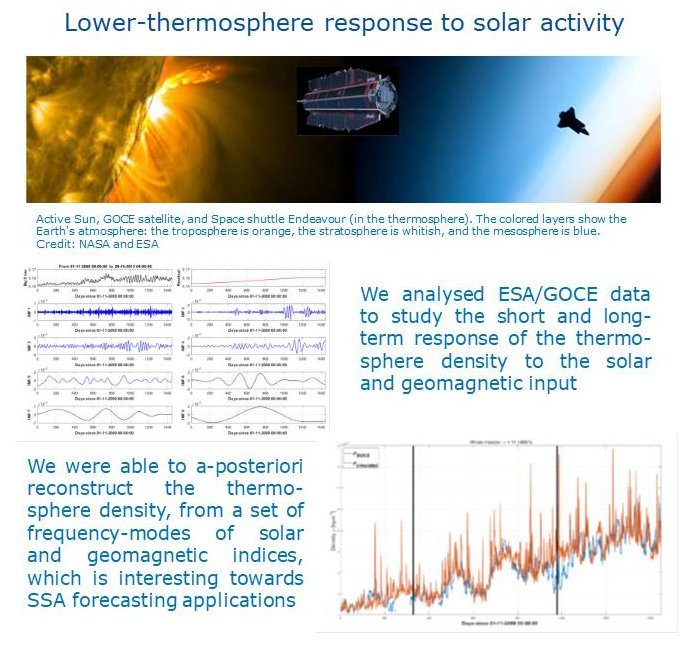
Since about 70% of the current operative satellites are in LEO, the expansion of the thermosphere increases drag on satellites and, changing their orbits, increases the need for orbital maneuvers with effects on orbital station-keeping and satellite life-time. The same effect is present in the case of the space debris (over 70% of the debris are in LEO).
By analyzing more than four years of data from extremely precise accelerometers, capable of measuring small accelerations (1 part out of 10 million of Earth’s gravity acceleration), on board the ESA/GOCE mission we connected the density variations of the thermosphere to the solar and geomagnetic activity. In order to model the density of the thermosphere to the solar and magnetospheric signals, we used the frequency modes that have the greatest impact on the thermosphere’s density.
Publication: Bigazzi A, Cauli C., Berrilli F., 2020, Annales Geophysicae, Volume 38, Issue 3, 2020, pp.789-800, DOI: 10.5194/angeo-38-789-2020 https://angeo.copernicus.org/articles/38/789/2020/angeo-38-789-2020.pdf
Intermittency and Passive Scalar Nature of Electron Density Fluctuations in the High-Latitude Ionosphere at Swarm Altitude
Papers from SWICo members
G. Consolini, P. De Michelis, T. Alberti, I. Coco, F. Giannattasio, R. Tozzi, and V. Carbone
The Sun interaction with the magnetosphere-ionosphere system can induce turbulent fluctuations in magnetic and electric fields and plasma density in the high-latitude ionosphere, particularly during geomagnetically disturbed periods. Here, we focus on the electron density fluctuations as observed by one of the satellites of the ESA Swarm constellation, and we show how such fluctuations are strongly intermittent in nature. Furthermore, we demonstrate that the anomalous scaling features of the electron density fluctuations are those expected for a passive scalar quantity in fluid turbulence.
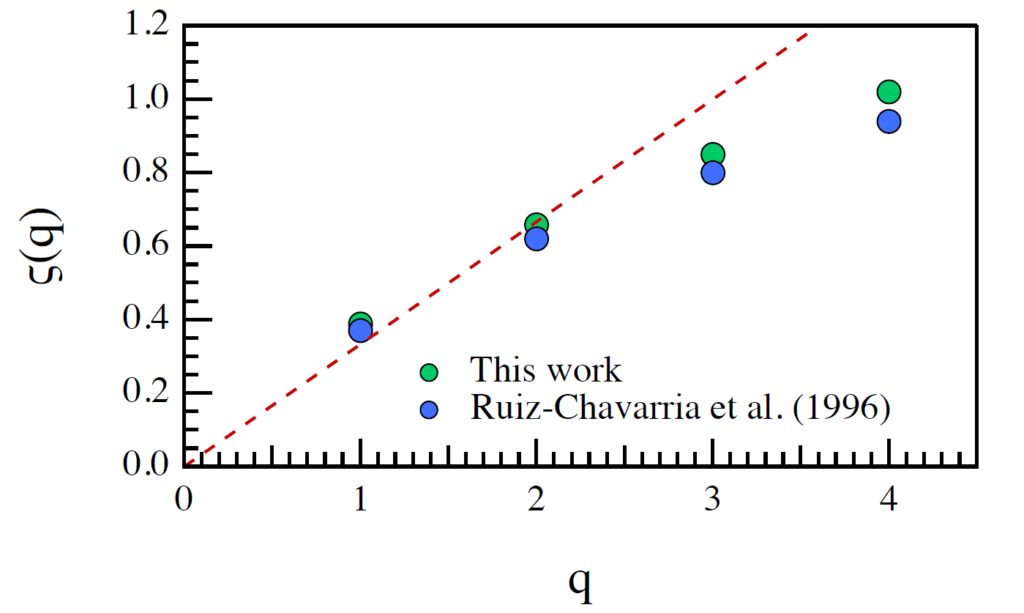
Publication: G. Consolini, P. De Michelis, T. Alberti, I. Coco, F. Giannattasio, R. Tozzi, and V. Carbone, Intermittency and Passive Scalar Nature of Electron Density Fluctuations in the High-Latitude Ionosphere at Swarm Altitude, Geophys. Res. Lett., 2020.
https://doi.org/10.1029/2020GL089628
On the 2015 St. Patrick Storm Turbulent State of the Ionosphere: Hints from the Swarm Mission
Papers from SWICo members
P. De Michelis, A. Pignalberi, G. Consolini, I. Coco, R. Tozzi, M. Pezzopane, F. Giannattasio and G. Balasis
We analysed the electron density fluctuations in the high-latitude ionosphere during the St. Patrick’s geomagnetic storm occurred on 17 March 2015, in order to investigate the possible turbulent nature of the ionospheric plasma. Electron density measurements were taken in both hemispheres from two of the three ESA Swarm satellites (A and B), covering the time period between 16 and 22 March 2015.
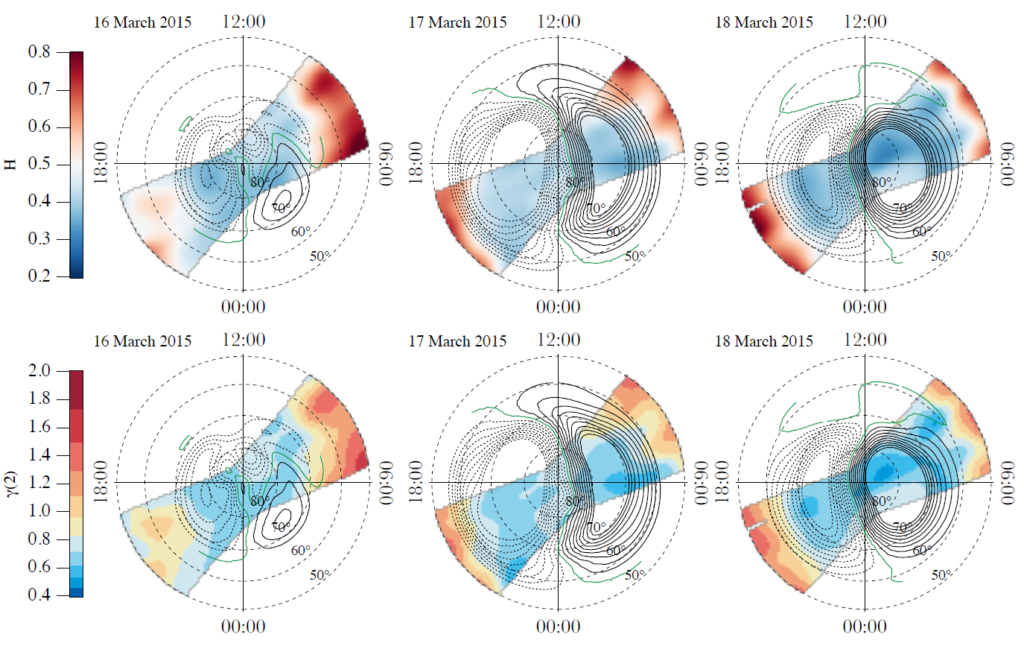
We reconstructed the Rate Of change of electron Density Index (RODI), which can be considered as a proxy for the presence of plasma irregularities, and compared it with quantities related to the spectral properties of the electron density fluctuations. We found that, independently of the different phases of the analyzed geomagnetic storm, the observed fluctuations pattern seems to support the idea of a fluid and/or magnetohydrodynamic turbulence as the main cause of the high values of RODI recorded at high latitudes in the auroral and polar cap regions.
Publication: P. De Michelis, A. Pignalberi, G. Consolini, I. Coco, R. Tozzi, M. Pezzopane, F. Giannattasio and G. Balasis, On the 2015 St. Patrick Storm Turbulent State of the Ionosphere: Hints from the Swarm Mission, J. Geophys. Res.: Space Physics, 125, 2020.
https://doi.org/10.1029/2020JA027934
Linear vs nonlinear methods for detecting magnetospheric and ionospheric current systems patterns
Papers from SWICo members
T. Alberti, F. Giannattasio, P. De Michelis and G. Consolini.
The geomagnetic field time series can be viewed as a superposition of signals which represent the different contributions to it at different scales coming from various sources both internal and external to the Earth. Here, we apply two different methods of analysis in order to recognize in the magnetic field of external origin the different contributions coming from external sources, making use of measurements of the vertical component of the geomagnetic field (directed away from the Earth’s center) recorded by the European Space Agency (ESA) Swarm A and B satellites at low and mid latitudes during a geomagnetically quiet period.
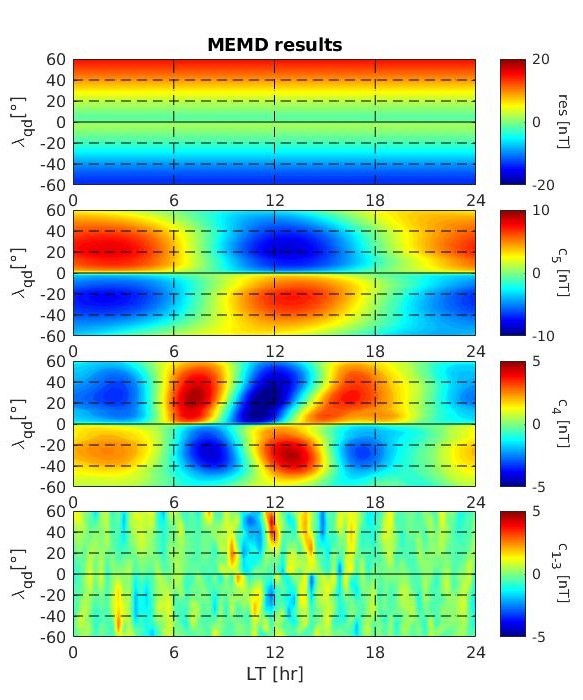
The first is a linear method, that is, the Empirical Orthogonal Functions (EOF); the second is a nonlinear one, i.e. the Multivariate Empirical Mode Decomposition (MEMD). As the external contributions to the magnetic signal are intrinsically nonlinear, the MEMD seems to give better results with respect to EOF, and only five modes and a residue are necessary to reproduce the different contributions coming from the external sources against the 26 modes that are necessary in the case of the EOF. This study is an example of the potential of the MEMD for the analysis of the geomagnetic field of external origin, and of its capability to separate the ionospheric from the magnetospheric contributions in a simple and rapid way.
Publication: T. Alberti, F. Giannattasio, P. De Michelis and G. Consolini, Linear vs nonlinear methods for detecting magnetospheric and ionospheric current systems patterns, Earth and Space Science, 2020.
https://doi.org/10.1029/2019EA000559
On the multifractal features of low-frequency magnetic field fluctuations in the field-aligned current ionospheric polar regions: Swarm observations
Papers from SWICo members
G. Consolini, P. De Michelis, T. Alberti, F. Giannattasio, I. Coco, R. Tozzi, and T. T. S. Chang
In this work we have characterized the magnetic field fluctuations in the high latitude ionosphere by means of high resolution magnetic measurements (50 Hz) from the European Space Agency Earth’s observation mission Swarm.
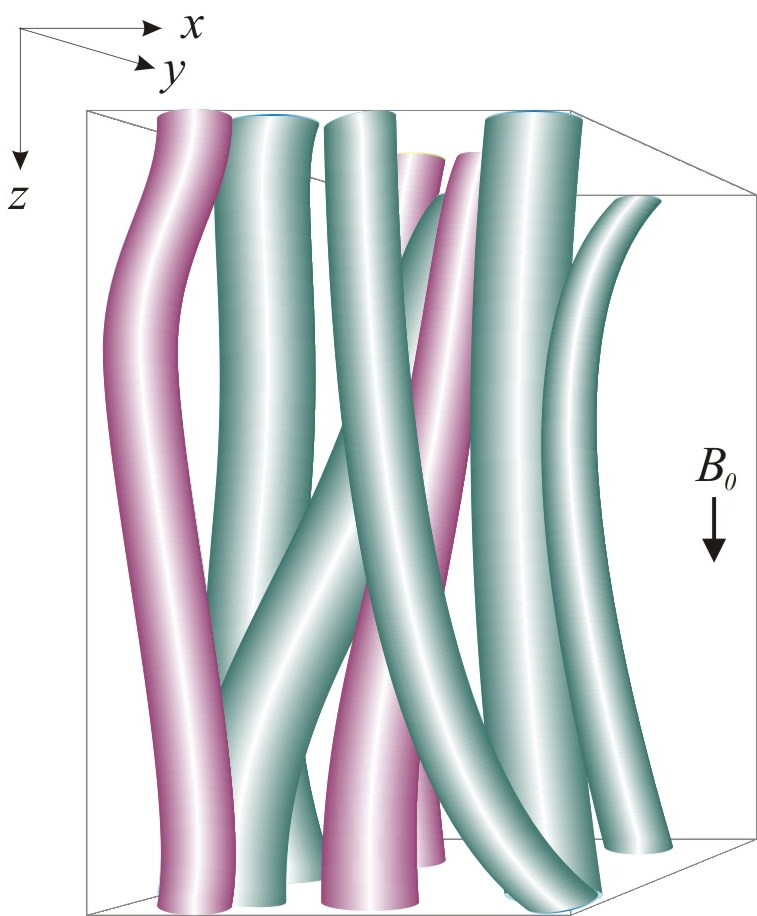
We found anomalous spatiotemporal scaling features of magnetic field fluctuations in regions where field‐aligned currents occur, at spatial scales in the range 0.8–80 km (timescales in the range 0.1–10 s). The nature of these fluctuations is multifractal, suggesting a highly complex structure of the field‐aligned currents. Our results support the hypothesis that field‐aligned currents are filamentary in nature, and this paves the way to new perspectives in the comprehension of the physical processes responsible for the magnetospheric‐ionospheric coupling.
Publication: G. Consolini, P. De Michelis, T. Alberti, F. Giannattasio, I. Coco, R. Tozzi, and T. T. S. Chang, On the multifractal features of low-frequency magnetic field fluctuations in the field-aligned current ionospheric polar regions: Swarm observations, J. Geophys. Res.: Space Physics, 125, 2020.
https://doi.org/10.1029/2019JA027429
Neural network based model for global Total Electron Content forecasting
Papers from SWICo members
Claudio Cesaroni, Luca Spogli, Angela Aragon-Angel, Michele Fiocca, Varuliator Dear, Giorgiana De Franceschi, Vincenzo Romano
We describe a novel empirical model to forecast, one day in advance, the Total Electron Content (TEC) at global scale. The technique is based on the Global Ionospheric Map (GIM), provided by the International GNSS Service (IGS), and exploits a nonlinear autoregressive neural network with external input (NARX) applied to selected TEC time series for soma particular GIM grid points (24 h single-point TEC forecasting), taking into account the actual and forecasted geomagnetic conditions. To extend the forecasting at a global scale, the technique leverages of the NeQuick2 Model fed by an effective sunspot number R12 (R12eff), calculated by minimizing the root mean square error (RMSE) between NARX output and NeQuick2 applied at the same GIM grid points. This new approach is able to reproduce the behavior of the ionosphere especially during disturbed periods.
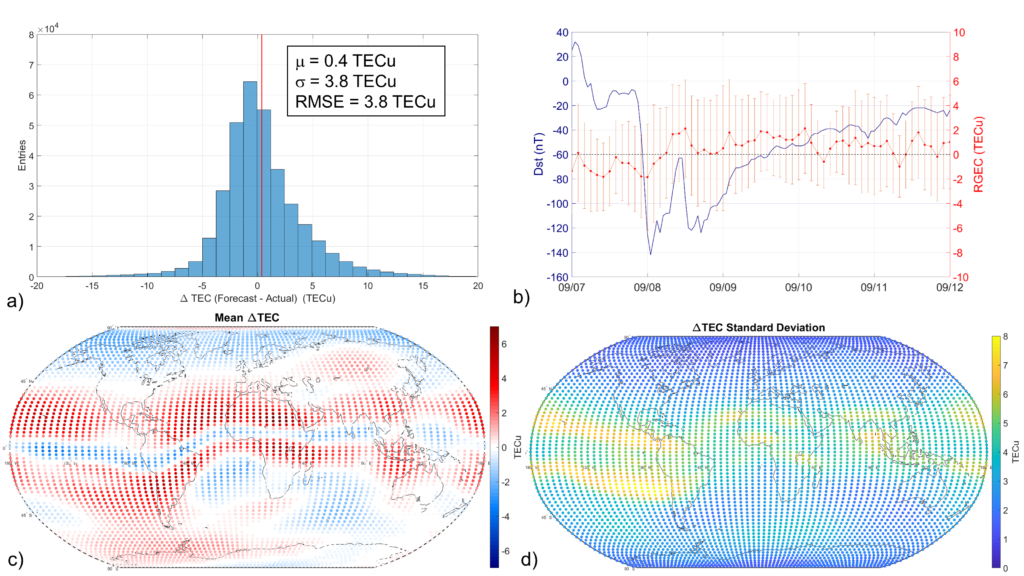
The performance of the forecasting model is extensively validated under different geospatial conditions, against both TEC maps products by UPC (Universitat Politècnica de Catalunya) and independent TEC data from Jason-3 spacecraft. The validation gives very satisfactory results in terms of RMSE, as it has been found to range between 3 and 5 TECu. RMSE depend on the latitude sectors, time of the day, geomagnetic conditions, and provide a statistical estimation of the accuracy of the 24-h forecasting technique even over the areas poorly covered by GNSS receivers (i.e. the oceans). The validation of the forecasting during five geomagnetic storms reveals that the model performance is not deteriorated during disturbed periods. This 24-h empirical approach is currently implemented on the Ionosphere Prediction Service (IPS), a prototype platform to support different classes of GNSS users in order to support the mitigation of the ionospheric effects on GNSS based technologies.
Publication: Cesaroni, C., Spogli, L., Aragon-Angel, A., Fiocca, M., Dear, V., De Franceschi, G., & Romano, V. (2020). Neural network based model for global Total Electron Content forecasting. Journal of Space Weather and Space Climate, 10, 11.
https://www.swsc-journal.org/articles/swsc/abs/2020/01/swsc190061/swsc190061.html
On the Analytical Description of the Topside Ionosphere by NeQuick: Modeling the Scale Height through COSMIC/FORMOSAT-3 Selected Data
Papers from SWICo members
Alessio Pignalberi, Michael Pezzopane, David R. Themens, Haris Haralambous, Bruno Nava, Pierdavide Coïsson
The topside part of the ionosphere extends from the F2-layer peak, corresponding to the ionospheric electron density maximum, to the plasmasphere. Developing a reliable model of the topside ionosphere is one of the most difficult tasks because instruments commonly used to probe the ionosphere, namely ionosondes, are only capable of sounding the region below the F2-layer peak. The topside ionosphere is characterized by a monotonic decrease of the electron density as the ion population smoothly transitions from the heavy O+ ions to the lighter H+ and He+ ions. This behavior is described by means of monotonically decreasing analytical functions dependent on a parameter called topside scale height whose exact description is the most challenging task for the topside ionosphere modeling.
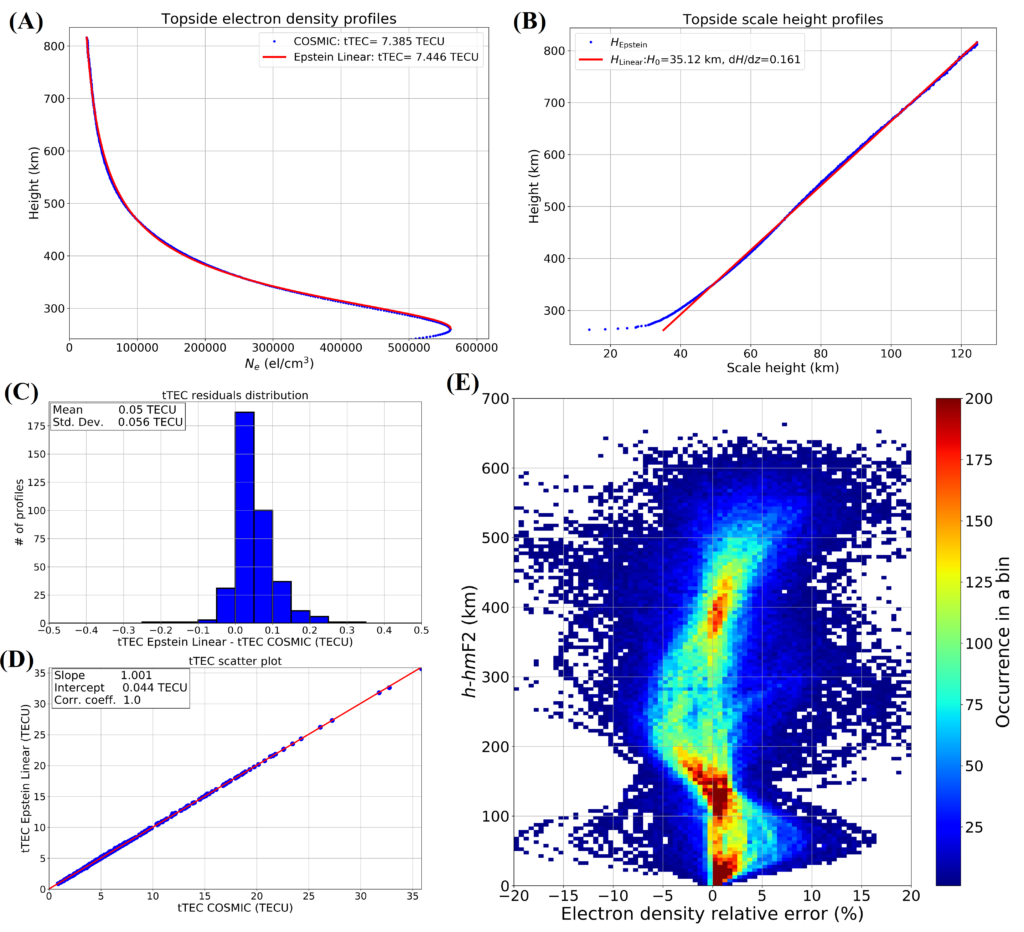
In this paper, the analytical description of the topside ionosphere included in the NeQuick model is deeply analyzed. The NeQuick modeled scale height behavior is first studied at infinity and then for the lowest part of the topside region through an expansion in Taylor series near the F2-layer peak. The significant influence of the NeQuick topside parameters in the modeling of the topside profile is investigated in detail and, in particular, it is shown that for the lowest part of the topside the model assumes a linearly increasing trend of the topside scale height. Afterwards, the NeQuick topside formulation is inverted to derive a fully analytical expression of the topside scale height as a function of the electron density and F2-layer peak parameters. This expression has been applied to a selected and very reliable dataset of COSMIC/FORMOSAT-3 Radio Occultation profiles. The performed statistical analyses strongly support the supposed linear trend of the topside scale height for the lowest part of the topside ionosphere, as embedded in NeQuick; thus, the developed technique might be relevant for Space weather modeling purposes.
Publication: A. Pignalberi, M. Pezzopane, D. R. Themens, H. Haralambous, B. Nava and P. Coïsson, “On the Analytical Description of the Topside Ionosphere by NeQuick: Modeling the Scale Height Through COSMIC/FORMOSAT-3 Selected Data,” in IEEE Journal of Selected Topics in Applied Earth Observations and Remote Sensing, vol. 13, pp. 1867-1878, 2020, doi: 10.1109/JSTARS.2020.2986683.
https://ieeexplore.ieee.org/document/9072529
The ionospheric irregularities climatology over Svalbard from solar cycle 23
Papers from SWICo members
Giorgiana De Franceschi, Luca Spogli, Lucilla Alfonsi, Vincenzo Romano, Claudio Cesaroni, Ingrid Hunstad
An unprecedented climatology of the ionospheric irregularities over the Svalbard (NO) derived from the longest Global Navigation Satellite Systems (GNSS) scintillation data series ever collected. Two receivers for scintillation monitoring are working at Ny-Ålesund, the first of which has been installed in late September 2003.

They are able to investigate auroral and cusp/cap regions and the length of the data series allows describing the Arctic ionosphere along about two solar cycles, from the descending phase of cycle 23 to almost the end of cycle 24. A detailed assessment of the long-term behaviour of the ionosphere under solar maximum and solar minimum conditions is provided including several periods of perturbed ionospheric weather caused by unfavourable heliogeophysical conditions. Since November 2015, a multi-constellation GNSS receiver has been deployed in Ny-Ålesund, providing the opportunity to perform the ionospheric climatology from Galileo signals. The results offer realistic features of the high latitude ionosphere, providing a broad spectrum of ionospheric reactions to different space weather conditions.
Publication: De Franceschi, G., Spogli, L., Alfonsi, L., Romano, V., Cesaroni, C., & Hunstad, I. (2019). The ionospheric irregularities climatology over Svalbard from solar cycle 23. Scientific reports, 9(1), 1-14.
https://www.nature.com/articles/s41598-019-44829-5
Role of the external drivers in the occurrence of low-latitude ionospheric scintillation revealed by multi-scale analysis
Papers from SWICo members
Luca Spogli, Mirko Piersanti, Claudio Cesaroni, Massimo Materassi, Antonio Cicone, Lucilla Alfonsi, Vincenzo Romano, and Rodolfo Gerardo Ezquer
By leveraging on the modal analysis provided by the Adaptive Local Iterative Filtering (ALIF) technique, this study focuses on the multi-scale variability of the amplitude scintillation on Global Navigation Satellite Systems (GNSSs) recorded over San Miguel de Tucumán (Argentina).

The site is nominally located below the expected position of the southern crest of the Equatorial Ionospheric Anomaly (EIA). The considered period is 1–31 March 2011, during which one minor and one moderate storm characterize the first half of the month, while generally quiet conditions of the geospace stand for the second half. The multiscale analysis is extended to helio-geophysical parameters to speculate on the possible relationship between forcing factors from the geospace and the ionospheric response. Resonant modes in the Akasofu (e) parameter are identified as likely related to the frequency components in the time evolution found for the amplitude scintillation index, hence modulating the scintillation itself. The analysis shows how the time-frequency structure of the amplitude scintillation can be characterized in terms of the resonant modes found in the combination of the Akasofu parameter. When assessed statistically, the proposed study can support models driven by interplanetary parameters aimed at characterizing the low latitude scintillation. The detection of resonant modes in the identified parameters can be used to define the Space Weather impact on GNSS signals recorded at ground.
Publication: Spogli, L., Piersanti, M., Cesaroni, C., Materassi, M., Cicone, A., Alfonsi, L., … & Ezquer, R. G. (2019). Role of the external drivers in the occurrence of low-latitude ionospheric scintillation revealed by multi-scale analysis. Journal of Space Weather and Space Climate, 9, A35
https://www.swsc-journal.org/articles/swsc/abs/2019/01/swsc180047/swsc180047.html
